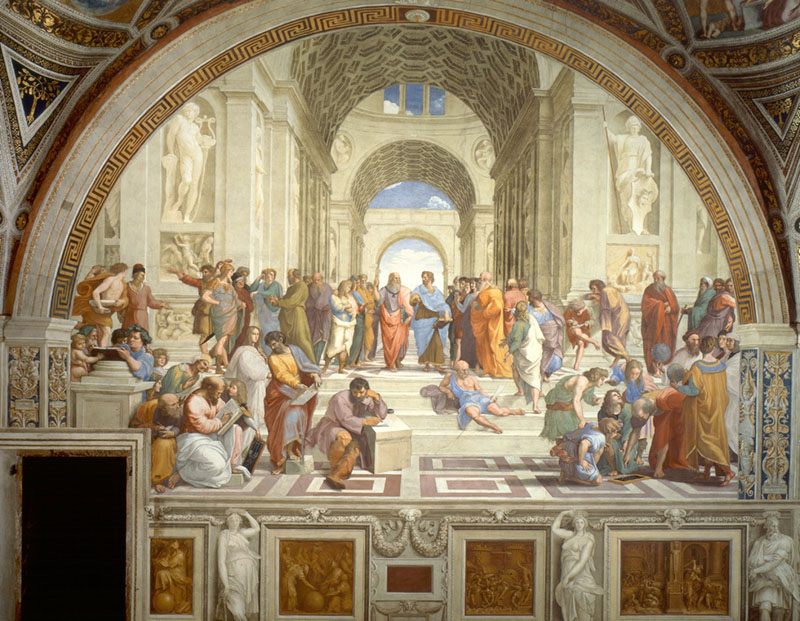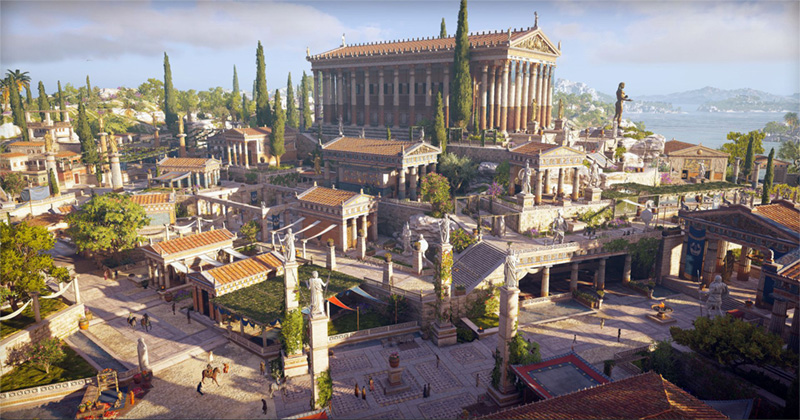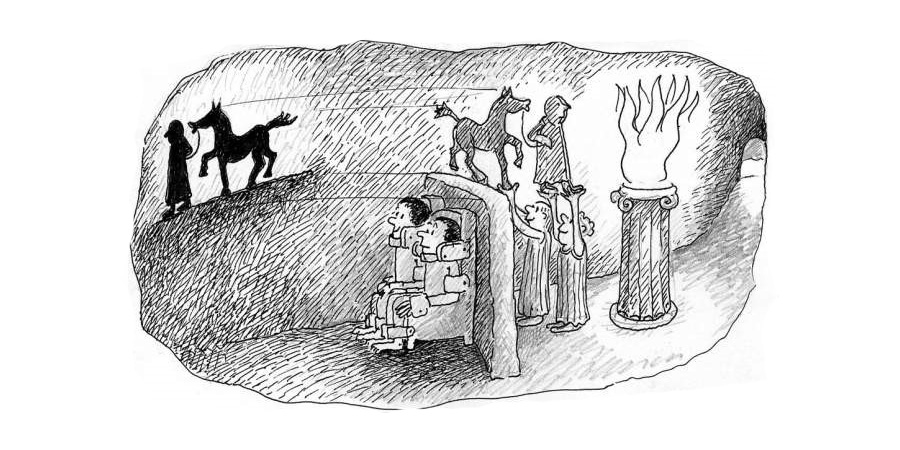The word philosophy means “love of wisdom.” Indeed, it is a love of wisdom that guides philosophers to explore the fundamental questions about who we are and why we’re here. On the surface, philosophy is a social science.
Philosophy touches on every subject you could possibly think of. It’s not just a bunch of old Greek guys asking each other questions over and over again (though it has its fair share of that as well). Philosophy has very real applications; from the ethical questions raised in government policy to the logic forms required in computer programming, everything has its roots in philosophy. Through philosophy, we are able to explore concepts like the meaning of life, knowledge, morality, reality, the existence of God, consciousness, politics, religion, economics, art, linguistics—philosophy has no bounds!
The School of Athens is a grand summing-up of Western civilization’s debt to the ancient world at midcareer, and to that world’s two greatest and most influential minds, perhaps the two greatest minds of all time: Plato and Aristotle. The painting shows the two philosophers larger than life size in an architectural setting of unparalleled splendor, with other philosophers arrayed on either side until they depict the entire wall. Plato stands slightly to the left and points heavenward toward a transcendent reality. Next to him stands his great teacher Socrates, and below him sits the mathematician Pythagoras.
Alongside are Plato’s closest disciples, his nephew Speusippus and Xenocrates, but also the ancient thinkers who emphasized the importance of intuition, the emotions, and speculative philosophy. Scholars have identified Plotinus, the father of Neoplatonism, and Epicurus, the founder of Epicureanism, as well as an Arab philosopher, Averroës; and a woman, the pagan priestess Hypatia. At their feet sits another philosopher, Heraclitus, which is in fact a portrait of Michelangelo. Over all their heads stands a statue of Apollo, the god of the arts and divine inspiration.

On the opposite side, on the right side, is the vigorous bearded gure of Aristotle, which we know Raphael drew from ancient busts of Aristotle in order to make it as accurate and lifelike as possible. Beside him are the representatives of science and empirical thought. There is Eudemus, the historian of mathematics, and Aristotle’s student Theophrastus, the father of botany. There are the scientists of the ancient Alexandrian school who were heavily influenced by Aristotle, like Ptolemy the astronomer and Euclid the geometer, which is actually a portrait of Raphael’s mentor Bramante (“portrayed so realistically,” Vasari says, “that he almost seems alive”).
Socrates was perhaps the first Western philosopher to focus on the value of human experience, instead of simply examining the world from a distance. He played a role in educating many of the brightest minds of his age, and his development of the Socratic method was one of the key milestones in all of human thought and knowledge.
The Socratic Method
Socrates is perhaps most famous for his Socratic method. First described in Plato’s Socratic Dialogues, Socrates and a pupil would have a discussion on a particular issue, and through a series of questions, Socrates would set out to discover the driving force behind how that individual’s beliefs and sentiments were shaped and in so doing, get closer to the truth. By continually asking questions, Socrates was able to expose contradictions in the way an individual thought, which allowed him to come to a solid conclusion.The Socratic method is still widely used to this day, most notably in law schools. First, a student will be asked to summarize a judge’s argument. Then, the student will be asked if he agrees with the judge’s argument. The professor will then act as devil’s advocate by asking a series of questions to make the student defend his decision. By using the Socratic method, students are able to start thinking critically and using logic and reasoning to create their arguments, while also finding and patching up holes in their positions.
Like Socrates, Plato believed philosophy was a process of continuous questioning and dialogues, and his writing appeared in this format. Two of the most interesting things about these dialogues are that Plato’s own opinions on the subject matters he wrote about were never explicitly stated (though with in-depth research, one might be able to infer his stance) and that he was never a character in his writing. Plato wanted readers to have the ability to form their own opinions on the subjects and not be told how to think (this also proves how skillful a writer he was). For this reason, many of his dialogues do not reach a concise conclusion. Those that do, however, allow for possible counterarguments and doubts. Plato’s dialogues dealt with a variety of subject matters, including things such as art, theater, ethics, immortality, the mind, and metaphysics. There are at least thirty-six dialogues written by Plato, as well as thirteen letters (though historians dispute the letters’ authenticity).
One of the most important concepts Plato developed was his theory of Forms. Plato states that reality exists on in specific levels. In The Republic and another well-known dialogue, Phaedrus, Plato discusses his understanding of rationality and the soul.
“Neoplatonism” refers to a school of thought that began in approximately 245 ce, when a man called Plotinus moved from the intellectual centre of the Eastern Mediterranean, Alexandria, Egypt, to settle in the capital of the Roman Empire, where he began teaching his interpretation of Plato’s philosophy, gaining many disciples and followers.
The Enneads are comprised of six groups of nine treatises, hence the name (from Greek ennea, nine). These six books were arranged by Plotinus’s follower Porphyry, who organized them thematically from individual ethical concerns through cosmology, the nature of the soul, knowledge and individual transcendence, and the nature of the transcendent One. For our purposes, although there are gems scattered throughout the Enneads, the most important books are the fifth and sixth, in which Plotinus narrates aspects of the path from subject-object dualism to transcendent knowledge of ultimate reality.
In the sixth book, Plotinus confides some secrets of what we may call a spiritual anthropology in the form of a kind of spiritual reminiscence. He observes that in the “primeval” transcendent realm, there is no division, even though it may seem that there is. And we as individuals who exist in time, before coming to be “we were there,” “some of us even gods, pure souls and intellect united with the whole of reality; we were parts of the intelligible,” and indeed “we are not cut off even now.” This primeval transcendent reality is our true home; it is the ground of all that is; and it is possible for us to recognize it anew, because it does not ever change; it does not belong to the realm of transience, even though it is present throughout it.
Neoplatonism long infiltrated the Western history of ideas, and in continental philosophy it has always enjoyed respect and interest. Undoubtedly, it provides interesting philosophical arguments and insights as well as a philosophical structure, the unity and systematicity of which can only be admired. Its influences on our thought are surprisingly deep. And indeed, times are changing. In the twentieth century, scholars started to redeem Neoplatonism. This involved accepting it as a branch of Greek philosophy rather than pure spiritualism of some foreign, Eastern kind.

“The idea of man,” wrote Plotinus, one of Plato’s most distinguished disciples, three hundred years after his death, “is formed after that which is the prevailing and best part of him,” namely his soul. This assumption bridged the classical culture of the Greek and Roman world and the Christian culture of the Middle Ages. It permeated the humanism of the Italian Renaissance and animated the great debates of the Reformation and the early modern era. Even today, when scientists try to reduce all forms of consciousness to bioneural states, the existence of the self remains an elusive mystery. From every angle—historical, philosophical, religious, and cultural—the soul of Socrates is the starting point for everything to come. To be a human is to have a soul, Socrates and Plato tell us. Our soul is our true essence, our true identity. It is the soul that actively seeks to unlock the mysteries of the world, including the truth about reality.
What is the soul?
Plato as well as Aristotle would agree that ‘soul’ mainly refers to the ‘principle of life’, so if the soul is present in the body, it makes it ‘a living thing’, i.e. it turns such body into the living being it is. Thus it is because of the soul that a body becomes a living body, endowed with vital functions (such as breathing, perceiving, thinking, and so forth). When explaining what life is, Aristotle says that it is self-nourishment, growing, and decay (de An. 412a14–15); as is clear, this describes the most basic form of life recognized by Aristotle (the ‘nutritive or vegetative soul’; τὸ θρεπτικόν), and the soul, the principle or source of living beings (which includes plants, irrational and rational animals), is what guarantees that all that is ensouled is alive, since without soul there is no life. Thus plants (along with animals), insofar as they are living beings, have souls. It is true that Plato is particularly concerned with that the soul is immortal.
But it is equally certain that Plato, like Aristotle, associates the soul to the principle that allows the most basic vital functions to an organism, such as breathing (see Cra. 399d). Moreover, Plato identifies the soul with self-motion, or rather defines soul as a ‘motion capable of moving itself’ (Lg. 896a). But he also speaks of the soul as a ‘principle or source of movement’ (i.e. of other things; 895a2, 896b1–3) and as ‘what manages and resides’ (διοικοῦσαν καὶ ἐνοικοῦσαν) in absolutely all things that are in motion in any way (896d10-e1). If this is so, the soul also should manage the heaven. Thus, for Plato the cosmos or the universe, in as much as it is a living being, should have a soul (Tim. 34b-36b, 41d4–5).
The soul of reason. The light of truth. The path of dialectic leading to understanding, even of goodness itself. These are Plato’s great ideals. Still, the Myth of the Cave reveals a bitter truth: Most people prefer life in the cave. The world and institutions around us reflect it —and as Glaucon realized, people get upset and even furious when someone challenges their fondest illusions—what Francis Bacon would call the Idols of the Tribe—especially if everything else is collapsing around them.
The fact that Athens had sentenced Socrates to death was more than an unjust act. It was final proof that human institutions were awed by their nature, even those ostensibly concerned with democracy and justice, because they are all based on opinion and illusion. The fate of Socrates proved to Plato that true knowledge lay permanently beyond the reach of the masses. Indeed, as he implied in the Myth of the Cave, they are instinctively hostile toward its devotees. Truth on Plato’s terms is destined to be a quarry reserved for a tiny minority, those trained in the rigors of dialectic and who are ready to make the same arduous climb out of the cave that Socrates made, in order to discover how to lead a virtuous life and show others how to do the same.
For the purposes of this philosophical safari, he created his famed Academy in Athens, and composed his dialogues to serve as basic texts for his students. Through their dramatic settings and vivid characters, Plato turned Socrates’s insights into a complete theory of ethics (as in the Philebus), of love and friendship (the Symposium), of language (the Phaedrus), and of politics (the Gorgias and Republic). Socrates talked a lot about God and the gods. He even told his jurors that “God orders me to fulll the philosopher’s mission of searching into myself and other men,” and he seems to have believed that his inner voice that kept urging him to ask questions and seek knowledge was indeed the voice of God.
This article is a short excerpt from:
- Soul and Mind in Greek Thought. Psychological Issues in Plato and Aristotle by Marcelo D. Boeri, Yasuhira Y. Kanayama, Jorge Mittelmann
- The Cave and the Light Plato Versus Aristotle, and the Struggle for the Soul of Western Civilization by Arthur Herman
- Philosophy 101 From Plato and Socrates to Ethics and Metaphysics, an Essential Primer on the History of Thought by Paul Kleinman
- Versluis, Arthur. Platonic Mysticism: Contemplative Science, Philosophy, Literature, and Art (SUNY series in Western Esoteric Traditions)

